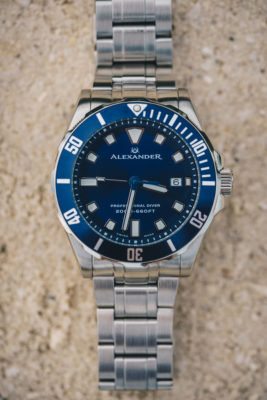No watch is totally waterproof, but a few fast facts on water-resistance wash away any worry. Now, you’ll never have to ask yourself again, “But can I, really?” (You probably can’t. We explain.)
Repeat after me: No watch is totally waterproof. No, seriously, say it out loud. It’s important. But here’s some relief: many watches are highly water-resistant, to the point that you don’t have to stress swimming, splashing, sailing, or showering. Once you understand the basics of water resistance, you’ll feel confident making the call — jump right in or take a moment to take off your watch.
Your Rating Is A Wreck Waiting to Happen
(Go Ahead, Say That Out Loud, Too)

Watchmakers design different watches for different levels of water-resistance. At first, this might seem easy to understand — if it says it’s 100 feet, it’s 100 feet, right? — but there’s more than meets the eye.
It’s a strange situation. Watchmakers don’t want you to wreck your watch. (Really, they don’t. We know so many watchmakers, and they all say the same on this one.)
But you can’t take a watch rated for 100 feet anywhere near 100 feet underwater. In fact, if you do, you’ll void the warranty entirely. So don’t do that.
Water Resistance by Rating
Water resistance is rated by feet or meters, but, really, by atmosphere, which is actually about water pressure. Atmosphere first refers to depth. For instance, if you dove 10 meters or about 33 feet, that would be one atmosphere, and the pressure would change by a little over 14 pounds per square inch.
See our dive watch Vathos in action with surfer Elaine Abonal in the Philippines.
Most people don’t swim at 33 feet below any water surface, though. You might think any old watch is just fine in the pool, then, right? Even the deep end rarely goes over 12 feet. What could go wrong?
Well, your watch, even a finely made watch, could cave under the pressure. That’s what could go wrong. That pressure increases when you jump in or submerge the watch or when you swim. Even if you all do is some sweet frog kicks, your watch feels it.
Here’s what you can really do with your water-resistant watch.

3 ATM = 30 meters or 100 feet
Walk in heavy rain or splash your wrists while washing your hands. Exciting stuff.
5 ATM = 50 meters or 165 feet
Shower. Just not too hot, because the steam poses a different threat. So no saunas or hot tubs. I mean, saunas and hot tubs, definitely. Just not in your watch.
10 ATM = 100 meters or 330 feet
Swim or snorkel, but not the gonzo snorkeling where that one guy always thinks he’s going to dolphin dive and his snorkel is still going to somehow work.
20 ATM = 200 meters or 660 feet
Free-diving, if you actually do this. Very few people do this. Those that do are amazing — otherworldly, in the realest sense of the word. You have to hold your breath for an insane amount of time to free-dive.
Also, if your watch is marked “professional diver,” you can go scuba diving.

